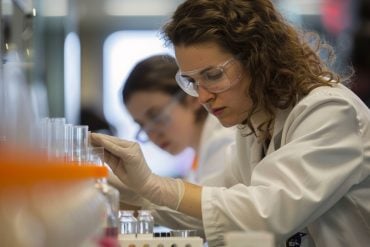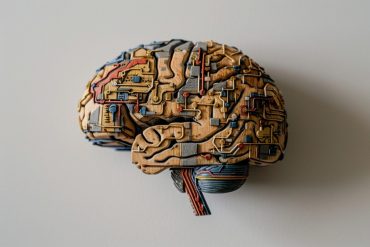Summary: Researchers have identified a social brain network in mice which, if tweaked, prompts mice to become more sociable. The findings shed new light on social communication problems in disorders like ASD.
Source: Duke University
The difference between a social butterfly and a lone wolf is actually at least eight differences, according to new findings by a team of Duke brain researchers.
By simultaneously spying on the electrical activity of several brain regions, the researchers found they could identify how social or solitary an individual mouse is. Then, by tweaking nodes within this social brain network, they showed they could prompt mice to be even more gregarious.
The research may lead to better diagnostic tools to understand how the brain changes in people with impaired social communication, such as those with autism spectrum disorder.
The new study appears in online Neuron on March 15.
Neuroscientists often conduct research by studying one tiny brain region at a time. They might select their favorite brain area based on past clues about its involvement in a given behavior, like social behavior, and study that area in isolation.
But looking only at one small brain region at a time is a big problem, said Dr. Kafui Dzirasa, the Howard Hughes Medical Investigator and K. Ranga Rama Krishnan Associate Professor in psychiatry and behavioral sciences at Duke. Much like the brain, a car is not just one thing but rather the product of assembled parts working together that varies across builds, he said.
“A car is not a steering wheel. A car is not tires. A car is not an engine. A car is not the speedometer. A car is not the headlights. You have to put them all together to get the car,” Dzirasa said. “When you put them all together, that’s when you can figure out how fast an individual car is moving. Certainly, the tires could be the same, but a Lamborghini does not move the same way a Honda Accord does.”
To figure out what drives mice to socialize, Dzirasa’s team first delicately implanted a recording device to capture the simultaneous electrical activity of eight brain regions that coordinate different aspects of social behavior, such as the prefrontal cortex and the dopamine-issuing ventral tegmental area.
Next, mice could choose to interact with another mouse or a small stack of black Legos while the researchers listened to their brain waves. Surprisingly, no single brain region’s electrical activity could predict how social a mouse was during the task. Even as a trained engineer, Dzirasa needed help putting together all of the complex brain wave data.
“We [neuroscientists] don’t know how to build the car. We just see wheels and tires. We don’t know how the system goes together,” said Dzirasa.
To help assemble a clearer picture of the data, Dzirasa connected with his long-time collaborator David Carlson, an assistant professor of civil and environmental engineering and biostatistics and bioinformatics, as well as a member of the Duke Institute for Brain Sciences. Carlson is an expert in the field of machine learning, a branch of artificial intelligence (AI) whereby computers get better at understanding complex data the more they’re given. Carlson helped to develop a new AI system to make sense of the brain wave data.
“What we’re trying to do is make this AI system that can learn and describe what’s going on in the brain and we’re trying to treat this AI as a collaborator in the scientific process,” Carlson said.
Importantly, the new AI tool could analyze all of the electrical activity from every brain region, tens of thousands of brain cells, and chart a new “social brain network” map. Now researchers could predict which animals preferred the company of their peers just by looking at the combined activity of their social brain network.
Armed with a new map and crystal ball for social tendencies, Dzirasa’s team tested whether activating this social brain network would make mice even more social. To gain precise control over these brain regions, the researchers used a light-based technique called optogenetics to enable them to instantly flick on specific brain regions at will. Lighting up prefrontal cortex brain cells provoked already outgoing mice to cozy up even more to another mouse, suggesting this social brain network both senses and directs social behavior.
As a final test, Dzirasa asked whether this social brain network model could detect impaired social behavior in a mouse model of autism. When Dzirasa’s team knocked out ANK2 in mice, a gene implicated in people with autism, their behavior confounded the machine learning tool. It could no longer predict how social a given mouse was based on its brain waves, suggesting the new machine learning tool is good at detecting aberrant electrical activity.

Dzirasa and Carlson are eager to explore how well these findings in mice hold up in people. Currently, Carlson’s team is collaborating with researchers at the Duke Center for Autism and Brain Development to evaluate whether this new machine learning tool can detect brain changes in typical and neurodiverse children.
Dzirasa hopes to develop better diagnostic tools and treatments for other social disorders. He likens this goal to cardiology: an EKG can measure anyone’s heart rate when they’re active and compare it to their baseline heart rate at rest, which varies widely across people. But there’s no equivalent tool for tracking and treating brain disorders in a similar way. Nor is there a pacemaker to dial in the “right” amount of gregariousness, another future goal of Dzirasa’s lab.
However, Dzirasa is keen to highlight that variation is normal, so this study and future work is important for understanding how things go awry outside someone’s typical range of sociability.
“Some people are more social than others. It doesn’t mean that people who are less social have a psychiatric illness, it means there are individual differences,” Dzirasa said. “If you want to link this ultimately to think about how humans are affected in psychiatric illness, you need to understand the individual.”
Funding: Support for the research came from the WM Keck Foundation, and the US National Institutes of Health (R01MH120158, R21MH104316, R01ES025549, 1R01EB026937, 1R01MH125430).
About this social neuroscience research news
Author: Karl Bates
Source: Duke University
Contact: Karl Bates – Duke University
Image: The image is in the public domain
Original Research: Closed access.
“Brain‐Wide Electrical Dynamics Encode Individual Appetitive Social Behavior” by Kafui Dzirasa et al. Neuron
Abstract
Brain‐Wide Electrical Dynamics Encode Individual Appetitive Social Behavior
Highlights
- Machine learning model discovers and integrates circuits into affective brain network
- Brain-wide network encodes rewarding social experience of individual mice
- Causal activation of network sub-circuits selectively induces social behavior
- Social brain network fails to encode individual behavior in a mouse model of autism
Summary
The architecture whereby activity across many brain regions integrates to encode individual appetitive social behavior remains unknown.
Here we measure electrical activity from eight brain regions as mice engage in a social preference assay. We then use machine learning to discover a network that encodes the extent to which individual mice engage another mouse.
This network is organized by theta oscillations leading from prelimbic cortex and amygdala that converge on the ventral tegmental area. Network activity is synchronized with cellular firing, and frequency-specific activation of a circuit within this network increases social behavior.
Finally, the network generalizes, on a mouse-by-mouse basis, to encode individual differences in social behavior in healthy animals but fails to encode individual behavior in a ‘high confidence’ genetic model of autism.
Thus, our findings reveal the architecture whereby the brain integrates distributed activity across timescales to encode an appetitive brain state underlying individual differences in social behavior.






